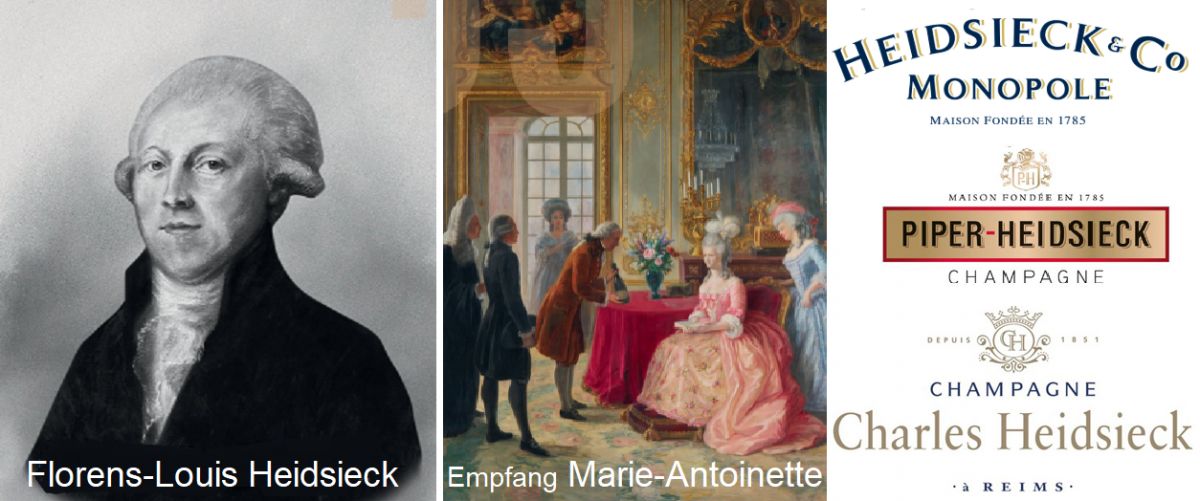Champagne house; see under Heidsieck.
Heidsieck
Today, there are three different champagne houses in Reims that use the name Heidsieck in their company name. The complicated story began when the German-born Florenz-Ludwig Heidsieck (1749-1828) from Westphalia settled in Reims in 1777 and henceforth called himself Florens-Louis Heidsieck. He married the daughter of the textile entrepreneur Nicolas Perthois. He began producing his own wine as early as 1780 and founded the champagne house Heidsieck & Co. with his son in 1785. In 1785, he was received by Queen Marie-Antoinette (1755-1793). When the founder's son died young, Florens-Louis Heidsieck took in three of his nephews.

Heidsieck champagne for Russia
Henri-Louis Waldbaum (1765-1843) joined the company in 1795, followed by Charles-Henri Heidsieck (1760-1824) in 1805 and Christian Heidsieck, Charles-Henri's younger brother, in 1808. Production was primarily based on sales to all the European royal and princely courts of the time, as champagne was the favourite drink of the ruling class. Shortly before Napoleon (1769-1821) invaded Russia in 1812, Charles-Henri Heidsieck initiated a publicity stunt. He announced that he would be travelling from Reims to Moscow on a white horse. He actually arrived in Moscow a few weeks before the French army with several crates of champagne in his travelling luggage.
Division into three companies
Charles-Camille Heidsieck (1822-1893), the son of Charles-Henri Heidsieck, founded the CharlesHeidsieck company in 1851 (see below). The remaining nephews decided to temporarily suspend trading. A short time later, Henri-Louis Waldbaum and Christian Heidsieck started trading in champagne again. This alliance soon fell apart and the nephews went their separate ways. As a result, three companies developed with the Heidsieck name, which meant that legal disputes were inevitable. When Heidsieck Monopole celebrated its centenary in 1885, there was trouble with the House of Charles Heidsieck. However, as Charles Heidsieck was later founded as Heidsieck Monopole and Piper-Heidsieck, the court allowed both Heidsieck Monopole and Piper-Heidsieck to refer to 1785. However, the long dispute has long since been buried.
Heidsieck & Co. Monopole
Henri-Louis Waldbaum founded the company Waldbaum-Heidsieck & Co. in 1834 with his brother-in-law Auguste Heidsieck (1794-1870). After Auguste Heidsieck's death, the company traded under various names such as Veuve Heidsieck and Luling, Goulden & Co. until 1910. In 1923, the company was bought by Edouard Mignot and the name Heidsieck & Co. Monopole. The company was gradually taken over by the champagne house Mumm until 1985 and then acquired by the champagne house Vranken-Pommery in 1998.
Vineyards and brands
The vineyards cover 110 hectares of vines, mainly Pinot Noir, in the renowned Ambonnay, Bouzy, Verzenay and Verzy sites....
Voices of our members

In the past, you needed a wealth of encyclopaedias and specialist literature to keep up to date in your vinophile professional life. Today, Wine lexicon from wein.plus is one of my best helpers and can rightly be called the "bible of wine knowledge".
Prof. Dr. Walter Kutscher
Lehrgangsleiter Sommelierausbildung WIFI-Wien